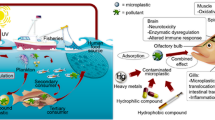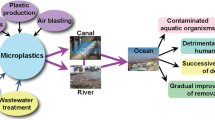Abstract
A comprehensive ecotoxicity assessment of three different nanosized TiO2 (with 16, 36 and 89 nm particle diameter) and one microscale TiO2 suspension (with 3264 nm particle diameter) was carried out with a special emphasis on the relation between product characteristics and toxic effect. The applied test battery included the combination of modified standardized tests (Aliivibrio fischeri bioluminescence inhibition test, Lemna minor growth inhibition test), and nonstandardized bioassays with unconventional physiological endpoints (Tetrahymena pyriformis phagocytic activity, the Daphnia magna heartbeat rate). Based on the lowest significant effect values, the tested aquatic organisms were the most sensitive to the microscale TiO2 suspension (with 3264 nm particle size). Although the three nanoscale TiO2 particles were aggregated in the A. fischeri and the L. minor growth media, significant inhibition rates were experienced at 0.1 and at 1 μg L─1 concentration of nTiO2 suspensions with 16 and 36 nm primary particle size, respectively. Larger aggregates may have also high impact on biological organisms. In case of the D. magna heartbeat rate test rapid agglomeration was avoided, but lower responses were found compared to other investigated systems. The short term T. pyriformis phagocytic activity test demonstrated outstanding sensitivity; three TiO2 suspensions were significantly toxic even at 0.1 μg L─1. The consequences of our study clearly indicated that nanoscale TiO2 may have an impact on the aquatic ecosystem which is strongly influenced by aggregation. The effect of exposure duration and concentration as contributing factors in nano-titanium dioxide mediated toxicity was also demonstrated.




Similar content being viewed by others
References
Aruoja, V., Dubourguier, H. C., Kasemets, K., & Kahru, A. (2009). Toxicity of nanoparticles of CuO, ZnO and TiO2 to microalgae Pseudokirchneriella subcapitata. Sci. Total Environ., 407, 1461–1468.
Baun, A., Hartmann, N. B., Grieger, K., & Kusk, K. O. (2008). Ecotoxicity of engineered nanoparticles to aquatic invertebrates: A brief review and recommendations for future toxicity testing. Ecotoxicology, 17, 387–395.
Behra, R., & Krug, H. (2008). Nanoecotoxicology−nanoparticles at large. Natl. Nanotechnology, 3, 253–254.
Bondarenko, O. M., Heinlaan, M., Sihtmäe, M., Ivask, A., Kurvet, I., Joonas, E., Jemec, A., Mannerström, M., Heinonen, T., Rekulapelly, R., Singh, S., Zou, J., Pyykkö, I., Drobne, D., & Kahru, A. (2016). Multilaboratory evaluation of 15 bioassays for (eco)toxicity screening and hazard ranking of engineered nanomaterials: FP7 project NANOVALID. Nanotoxicology, 10(9), 1229–1242.
Bour, A., Mouchet, F., Silvestre, J., Gauthier, L., & Pinelli, E. (2015). Environmentally relevant approaches to assess nanoparticles ecotoxicity: A review. Journal of Hazardous Materials, 283, 764–777.
Bouwmeester, H., Poortman, J., Peters, R. J., Wijma, E., Kramer, E., Makama, S., Puspitaninganindita, K., Marvin, H. J., Peijnenburg, A. A., & Hendriksen, P. J. (2011). Characterization of translocation of silver nanoparticles and effects on whole-genome gene expression using an in vitro intestinal epithelium coculture model. ACS Nano, 5(5), 4091–4103.
Buffet, P. E., Tankoua, O. F., Pan, J. F., Berhanu, D., Herrenknecht, C., & Poirier, L. (2011). Behavioural and biochemical responses of two marine invertebrates Scrobicularia plana and Hediste diversicolor to copper oxide nanoparticles. Chemosphere, 84, 166–174.
Buzea, C., Pacheco, I. I., & Robbie, K. (2007). Nanomaterials and nanoparticles: sources and toxicity. Biointerphases, 2(4), 17–71.
Clément, L., Hurel, C., & Marmier, N. (2013). Toxicity of TiO2 nanoparticles to cladocerans, algae, rotifers and plants—effects of size and crystalline structure. Chemosphere, 90, 1083–1090.
Farré, M., Pérez, S., Kantiani, L., & Barcelo, D. (2008). Fate and toxicity of emerging pollutants, their metabolites and transformation products in the aquatic environment. Trend. Anal. Chem., 27, 991–1000.
Fekete-Kertész, I., Kunglné-Nagy, Z., Gruiz, K., Magyar, Á., Farkas, É., & Molnár, M. (2015). Assessing toxicity of organic aquatic micropollutants based on the total chlorophyll content of Lemna minor as a sensitive endpoint. Period. Polytech. Chem., 59(4), 262–271.
Fekete-Kertész, I., Maros, G., Gruiz, K., & Molnár, M. (2016). The effect of TiO2 nanoparticles on the aquatic ecosystem: A comparative ecotoxicity study with test organisms of different trophic levels. Period. Polytech. Chem., 60(4), 231–243.
Froehner, K., Backhaus, T., & Grimme, L. H. (2000). Bioassays with Vibrio fischeri for the assessment of delayed toxicity. Chemosphere, 40(8), 821–828.
García, A., Espinosa, R., Delgado, L., Casals, E., González, E., Puntes, V., Barata, C., Font, X., & Sánchez, A. (2011). Acute toxicity of cerium oxide, titanium oxide and iron oxide nanoparticles using standardized tests. Desalination, 269(1–3), 136–141.
Hasselöv, M., & Kaegi, R. (2009). Analysis and characterization of manufactured nanoparticles in aquatic environments. In J. Lead & E. Smith (Eds.), Environmental and human health impacts of nanotechnology. Chichester: John Wiley & Sons.
Hebert, P. D. N., Remigio, E. A., Colbourne, J. K., Taylor, D. J., & Wilson, C. C. (2002). Accelerated molecular evolution in halophilic crustaceans. Evolution, 56, 909–926.
Heinlaan, M., Ivask, A., Blinova, I., Dubourguier, H. C., & Kahru, A. (2008). Toxicity of nanosized and bulk ZnO, CuO and TiO2 to bacteria Vibrio fischeri and crustaceans Daphnia magna and Thamnocephalus platyurus. Chemosphere, 71, 1308–1316.
Hund-Rinke, K., Baun, A., Cupi, D., Fernandes, T. F., Handy, R., Kinross, J. H., Navas, J. M., Peijnenburg, W., Schlich, K., Shaw, B. J., & Scott-Fordsmand, J. J. (2016). Regulatory ecotoxicity testing of nanomaterials—proposed modifications of OECD test guidelines based on laboratory experience with silver and titanium dioxide nanoparticles. Nanotoxicology, 10(10), 1442–1447.
ISO. (2010). ISO 21338:2010(E). Water quality—kinetic determination of the inhibitory effects of sediment, other solids and coloured samples on the light emission of Vibrio fischeri (kinetic luminescent bacteria test). Geneva: International Organization for Standardization.
Janusz, W., Sworska, A., & Szczypa, J. (1999). The structure of the electrical double layer at the titanium dioxide/ethanol solutions interface. Colloid. Surface. A, 152(3), 223–233.
Jiang, W., Mashayekhi, H., & Xing, B. (2009). Bacterial toxicity comparison between nano- and micro-scaled oxide particles. Environmental pollution, 157, 1619–1625.
Kahru, A., & Dubourguier, H. C. (2010). From ecotoxicology to nanoecotoxicology. Toxicology, 269, 105–119.
von der Kammer, F., Ferguson, P. L., Holden, P. A., Masion, A., Rogers, K. R., Klaine, S. J., Koelmans, A. A., Horne, N., & Unrine, J. M. (2012). Analysis of engineered nanomaterials in complex matrices (environment and biota): general considerations and conceptual case studies. Environmental Toxicology and Chemistry, 31(1), 32–49.
Klaine, S. J., Alvarez, P. J., Batley, G. E., Fernandes, T. F., Handy, R. D., Lyon, D. Y., Mahendra, S., McLaughlin, M. J., & Lead, J. R. (2008). Nanomaterials in the environment: behavior, fate, bioavailability and effects. Environmental toxicology and chemistry, 27, 1825–1851.
Kőhidai, L., Katona, L., & Csaba, G. (2003). Effects of steroid hormones on five functional parameters of Tetrahymena: evolutionary conclusions. Cell Biochemistry and Function, 21, 19–26.
Leitgib, L., Kálmán, J., & Gruiz, K. (2007). Comparison of bioassays by testing whole soil and their water extract from contaminated sites. Chemosphere, 66, 428–434.
Li, L., Sillanpää, M., Tuominen, M., Lounatmaa, K., & Schultz, E. (2013). Behavior of titanium dioxide nanoparticles in Lemna minor growth test conditions. Ecotoxicology and environmental safety, 88, 89–94.
Lichtenthaler, H. K. (1987). Chlorophylls and carotenoids: pigments of photosynthetic biomembranes. Method. Enzymol., 148, 350–382.
Menard, A., Drobne, D., & Jemec, A. (2011). Ecotoxicity of nanosized TiO2. Review of in vivo data. Environ. Pollut., 159, 677–684.
Minetto, D., Libralato, G., & Volpi Ghirardini, A. (2014). Ecotoxicity of engineered TiO2 nanoparticles to saltwater organisms: An overview. Environment international, 66, 18–27.
Minetto, D., Libralato, G., & Volpi Ghirardini, A. (2016). Saltwater ecotoxicology of Ag, Au, CuO, TiO2, ZnO and C60 engineered nanoparticles: An overview. Environ. Intern., 92–93, 189–201.
Neal, A. L. (2008). What can be inferred from bacterium-nanoparticle interactions about the potential consequences of environmental exposure to nanoparticles? Ecotoxicology, 17, 362–371.
Nowack, B. (2009). The behavior and effects of nanoparticles in the environment. Environmental Pollution, 157, 1063–1064.
Nur, Y., Leada, J. R., & Baalousha, M. (2015). Evaluation of charge and agglomeration behavior of TiO2 nanoparticles in ecotoxicological media. Sci. Total Environ., 535, 45–53.
Oberdorster, G., Oberdorster, E., & Oberdorster, J. (2005). Nanotoxicology: an emerging discipline evolving from studies of ultrafine particles. Environmental health perspectives, 113, 823–839.
OECD 201. (2011). Freshwater algae and cyanobacteria, growth inhibition test. Paris: OECD Publisher.
OECD 202. (2004). OECD guideline for testing chemicals. Daphnia magna acute immobilization test. Paris: OECD Publisher.
Poda, A. R., Bednar, A. J., Harmon, A., Hull, M., Mitrano, D. M., Ranville, J. F., Steevens, J. (2011). Characterization of silver nanoparticles using flow-field flow fractionation interfaced to inductively coupled plasma mass spectrometry. Journal of Chromatography. A, 1218(27), 4219–4225.
Rajapakse, K., Drobne, D., Valant, J., Vodovnik, M., Levart, A., & Marinsek-Logar, R. (2012). Acclimation of Tetrahymena thermophila to bulk and nano-TiO2 particles by changes in membrane fatty acids saturation. Journal of Hazardous Materials, 221–222, 199–205.
Rivetti, C., Campos, B., & Barata, C. (2016). Low environmental levels of neuro-active pharmaceuticals alter phototactic behaviour and reproduction in Daphnia magna. Aquatic Toxicology, 170, 289–296.
Schiess, N., Csaba, G., & Kőhidai, L. (2001). Chemotactic selection with insulin, di-iodotyrosine and histamine alters the phagocytotic responsiveness of Tetrahymena. Comp. Biochem. Phys. C, 128(4), 521–530.
Seitz, F., Bundschuh, M., Rosenfeldt, R. R., & Schulz, R. (2013). Nanoparticle toxicity in Daphnia magna reproduction studies: the importance of test design. Aquatic Toxicology, 126, 163–168.
Strigul, N., Vaccari, L., Galdun, C., Wazne, M., Liu, X., Christodoulatos, C., & Jasinkiewicz, K. (2009). Acute toxicity of boron, titanium dioxide, and aluminum nanoparticles to Daphnia magna and Vibrio fischeri. Desalination, 248, 771–782.
Sun, T. Y., Gottschalk, F., Hungerbühler, K., & Nowack, B. (2014). Comprehensive probabilistic modelling of environmental emissions of engineered nanomaterials. Environmental Pollution, 185, 69–76.
Tan, L. Y., Huang, B., Xu, S., Wei, Z. B., Yang, L. Y., & Miao, A. J. (2016). TiO2 nanoparticle uptake by the water flea Daphnia magna via different routes is calcium-dependent. Environmental Science & Technology, 50, 7799–7807.
Therezien, M., Thill, A., & Wiesner, M. R. (2014). Importance of heterogeneous aggregation for NP fate in natural and engineered systems. Sci. Total Environ., 485–486, 309–318.
Tiede, K., Tear, S. P., David, H., & Boxall, A. B. (2009). Imaging of engineered nanoparticles and their aggregates under fully liquid conditions in environmental matrices. Water Research, 43(13), 3335–3343.
Ud-Daula, A. (2009). Catecholamine homeostasis in Tetrahymena species and high throughput toxicity testing of selected chemicals and ultrafine particles. [dissertation]. Technische Universität München.
Ujaczki, É., Klebercz, O., Feigl, V., Molnár, M., Magyar, Á., Uzinger, N., & Gruiz, K. (2015). Environmental toxicity assessment of the spilled Ajka red mud in soil microcosms for its potential utilisation as soil ameliorant. Period. Polytech. Chem., 59(4), 253–261.
Uyar, A. E., Robichaud, C., Darby, M. R., Wiesner, M., & Zucker, L. G. (2008). Nano-titanium dioxide: risk assessment. Cambridge, Massachusetts: NBER Emerging Industries Conference.
Villegas-Navarro, A., Rosas-L, E., & Reyes, J. L. (2003). The heart of Daphnia magna: effects of four cardioactive drugs. Comparative biochemistry and physiology. C, 136, 127–134.
Zhu, X., Chang, Y., & Chen, Y. (2010). Toxicity and bioaccumulation of TiO2 nanoparticle aggregates in Daphnia magna. Chemosphere, 78, 209–215.
Zuin, S., Micheletti, C., Critto, A., Pojana, G., Johnston, H., Stone, V., Tran, L., & Marcomini, A. (2011). Weight of evidence approach for the relative hazard ranking of nanomaterials. Nanotoxicology, 5(3), 445–458.
Acknowledgements
The financial supports of the National Innovation Office (TECH_08-A4/2-2008-0161, CDFILTER project and TECH_09-A4-2009-0129, SOILUTIL project) and the New Hungary Development Plan (TÁMOP-4.2.1/B-09/1/KMR-2010-0002) are greatly acknowledged. We are grateful to Emese Vaszita for her contribution to language editing of the manuscript.
Supported through the New National Excellence Program of the Ministry of Human Capacities.
Author information
Authors and Affiliations
Corresponding author
Additional information
Highlights
• The A. fischeri bioluminescence inhibition test showed time dependent sensitivity to nTiO2.
• Aggregates and agglomerates of TiO2 particles pose adverse effects representing an important exposure pathway.
• The lowest significant effect concentrations determined by our test battery are comparable to environmental concentrations.
• Behavioural and physiological assays are highly beneficial in assessing the impact of nanoparticles.
Rights and permissions
About this article
Cite this article
Fekete-Kertész, I., Piszmán, D. & Molnár, M. Particle Size and Concentration Dependent Ecotoxicity of Nano- and Microscale TiO2 —Comparative Study by Different Aquatic Test Organisms of Different Trophic Levels. Water Air Soil Pollut 228, 245 (2017). https://doi.org/10.1007/s11270-017-3394-5
Received:
Accepted:
Published:
DOI: https://doi.org/10.1007/s11270-017-3394-5




